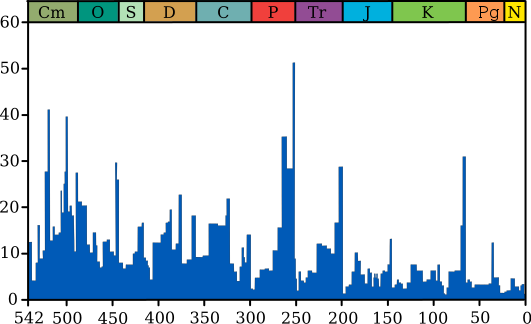
Land and sea timing may have differed in the mass die-off 250 million years ago.
Never mind theories of consciousness getting rocked, see this on the Permian extinction from ScienceDaily:
New evidence gathered from the Karoo Basin in South Africa sheds light on a catastrophic extinction event that occurred more than 250 million years ago and wiped out more than 90 percent of life in Earth’s oceans and about 70 percent of animal species on land.
The new evidence derives from a key volcanic ash deposit that the team discovered in rock layers, or strata, that were reported to chronicle the mass extinction. By dating the volcanic ash-bearing deposit, researchers concluded that two phases of this extinction — one on land, the other in the oceans — occurred at least 1 million years apart, as opposed to roughly at the same time, as the geoscience community has assumed for decades.
However, the timing of the extinction on land has been more challenging to date definitively. This is due, in part, to a dearth of datable volcanic deposits below and above plant and animal fossils in rocks surrounding the boundary where the Permian period ends and the Triassic begins, said Dr. John Geissman, professor and head of the Department of Geosciences and one of the authors of the study.
“There has been some concern in the scientific community about whether the extinction among vertebrates on land was actually coincident with that in the marine realm in terms of their timing,” Geissman said. “Nonetheless, many researchers have just tacitly assumed that the land event occurred roughly concurrently with the marine extinction.”
Maybe not.
The team dated the volcanic ash bed at about 253.5 million years old, so moving forward in time 200,000 years — or 60 meters — would indicate the terrestrial phase of the extinction took place about 253.3 million years ago, according to the study.
“This study places the terrestrial vertebrate turnover about 1.5 million years earlier than the accepted estimated age of the marine end Permian-extinction,” Geissman said. “Even if we conservatively say they were a million years apart, that still challenges long-held assumptions about the largest extinction event in Earth’s history.” More.
At first glance, it may not matter a whole lot, as they are all still dead. But each new piece added to the puzzle replaces neat theory and assumption with messy fact. As noted earlier,
The more we learn about the history of life on earth, the less evolution is theory and the more it is history. It is less like Epicureanism and more like World War II. That cannot be good for Darwinian thinking, which fills in large gaps in history by the exercise of theory. Things that “must have” happened if the theory is correct are assumed to have happened.
But history is not like that. Consider, for example, Pearl Harbor, when the Japanese crippled the U.S. Pacific fleet in a surprise attack, though the United States was not at war with Japan. Assume that the account broke off there. Maybe a theory can fill in the blanks for us and tell us what “had to” happen.
But then, what if we later discover more and more evidence for what actually happened? It will be bad news Tuesday for some theories developed in the absence of evidence — maybe for quite a few theories.
That’s a key reason that the hegemony of Darwin is weakening. So much that we now know either doesn’t fit the theory or could get on just fine without it. More.
Follow UD News at Twitter!